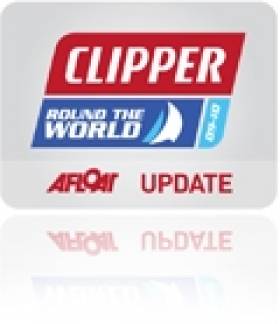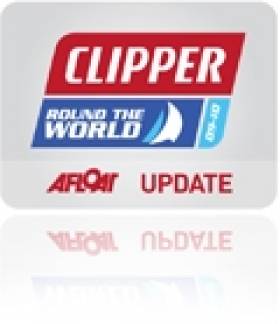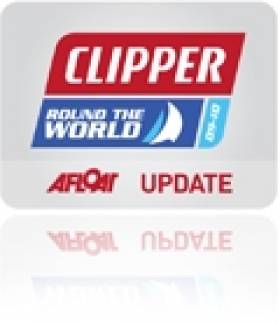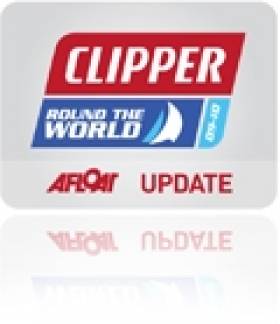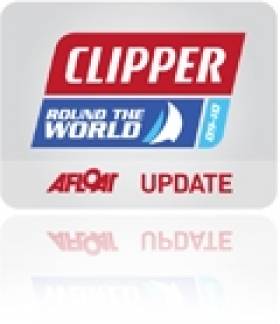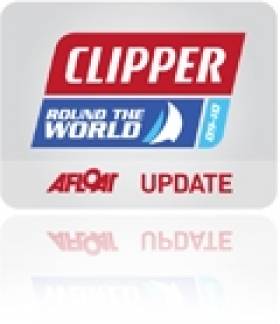Displaying items by tag: Clipper Round The World Race
Kinsale Ready for Clipper Festival
Kinsale is the first port of call in Europe for the final leg of the Clipper Round the World Yacht Race and the fleet, including the Irish boat “Cork”, have now left Canada and are on their way to Kinsale. To celebrate the race’s arrival the town of Kinsale plans a party to remember. Kinsale Clipper Stopover Carnival will extend a fantastic welcome to all the participants. The Carnival will take place from Friday 2nd to Sunday 4th July, with a whole host of free entertainment for all the family. The fleet of 10 Clipper Round the World yachts is expected to arrive during Friday/Saturday and the event, centred on Kinsale and, then on to Cork City, is estimated to be worth €10 million to the region.
The Carnival Weekend has something for everything and one of the centrepieces will be Live Music at the Square with local, national and international acts, featuring artists such as Ian Whitty and The Exchange; Aaron Dillon and Band; Novella Hermosa and Txutxukan.
Food and drink are key ingredients for a good carnival and there will be plenty of both at the fabulous Artisan Food Market on Long Quay where stallholders will participate in a market which will feature the finest artisan food to go, all from the locality. There will also be Tea Tents located at busking spots throughout the town offering the public a wide range of usual and unusual tea blends. The busking spots will feature performers such as The Invisible Men; Grant Goldie; The Fanzinis and their Cannonball Circus and Cork City String Quartet.
Highlights of the Carnival Weekend include “Ebb-Tide-Flow” an audio-guided walk on mp3 players. Designed by artist Fiona Hallinan and composer Alex Synge, the tour is accompanied by an original map and comprises a score and original text written for the Scilly walk. Kinsale Historical Walks with Dermot Ryan leaves daily at 10.30am and 3pm from the Tourist Office. Also, during the weekend, children and adults will be invited to come to the Methodist Church in the town to make a page for “The Clipper Adventure Book”.
Friday, July 2nd, will see the Kinsale Clipper Burrells. A Burrell is an evening of music in different venues, where, instead of the audience travelling to see different acts in different venues, the acts come to each venue in turn.
The Finale of what promises to a fun-filled weekend with free entertainment for everyone, on Sunday 4th July, will be the Kinsale Clipper Parade where the streets of Kinsale will be transformed into the mighty trade routes.
On Monday 5th & Tuesday 6th July come and see the Clipper Yachts at the Kinsale Yacht Club marina then, on Wednesday 7th July, 11am gather on Pier Road to wish farewell to the Clipper Fleet as they parade to Cork city for a three-day festival there.
There will be PARK & RIDE system in operation for the weekend, for information, pick up a traffic information leaflet at Kinsale Tourist Office or visit www.corkcoco.ie <http://www.corkcoco.ie>
The Kinsale Clipper Carnival is sponsored by Cork County Council, Cork City Council and Failte Ireland. For more details on the Clipper race visit www.corkclipperfestival.com
Cork Clipper Boat Leaves New York
With strong winds forecasted for the next couple of days, a confident Cork crew departed New York for the start of Race 11 of the Clipper 09-10 Round the World Yacht Race – an 800-mile sprint to Cape Breton Island, Nova Scotia.
Speaking ahead of the race start Cork’s skipper Hannah Jenner, said, “I’ve just been checking out the forecast and it looks like we’re going to have some stronger winds on this race. We’re looking at up to 30 knots downwind which means we’re going to have to build some serious arm muscles because the boat’s quite heavy, but it’s definitely looking more favourable than before.
“The race is a short one and so far we’ve kept in touch with the fleet for the first 48 hours, so if we can extend that a little bit on this one we should get a good result. Every time we go out we learn a little bit more about the boat and with our IRC handicap applied we stand every chance of doing well.”
The Clipper fleet treated New Yorkers to a parade of sail past the Statue of Liberty before heading out of the Hudson to the site of Ambrose Lighthouse where Race 11 got underway at 1645 local time (2045GMT) with a Le Mans start.
With winds touching the 30 knot mark, most crews opted for a Yankee 2 and reefed mainsail combination with Cape Breton Island andCalifornia first out of the blocks after the Le Mans start. Overall race leaders Spirit of Australia were in hot pursuit though and followed Cape Breton Island's lead in shaking out their reef shortly after the start with the rest of the fleet soon following suit.
Despite their poorest result of the ten month series on the latest leg of the race, Spirit of Australia is still holding a comfortable lead at the top of the overall leaderboard. But with four races still to go and the performance amongst their competitors improving all the time, the Australian team cannot afford to rest on their laurels.
Competition is exceptionally close amongst the teams currently lying in the three places below Spirit of Australia, with just two points separating Cape Breton Island, Team Finland and Jamaica Lightning Bolt, who hold second, third and fourth place respectively. Hull & Humber are also not out of contention for an overall podium and with their first podium place result in Race 8 they will be hungry for another. Further down the order there is Asian rivalry between Uniquely Singapore, who scored their first victory in Race 10, and Qingdao who despite four third place results have yet to make it to the top of the podium. The team on board Cork will be hoping to show what their Challenge 67 is capable of and with stronger weather forecasted for this race than the last, they will be fully in contention. Keen also to prove their worth are California and Edinburgh Inspiring Capital who have yet to get a podium place result – so the final four races of Clipper 09-10 promise to be fiercely contested.
In addition to the closely fought points for the individual legs there is an extra dimension to the 800-mile race from New York to Cape Breton Island. Designated the ‘Eagle Spirit Race’ by Cape Breton Island’s sponsors, with the inspiration coming from the magnificent eagle that emblazons the side of their yacht, the team’s will be competing for the Eagle Spirit Trophy. There are three magnificent trophies up for grabs, each depicting a soaring eagle, which will be awarded to the podium placed yachts at the Race 11 prize giving ceremony on June 14 in Sydney.
There is a centuries old tradition of welcoming visitors to Nova Scotia which continues to be extended by the people of Cape Breton Island, Nova Scotia today. Their famous warm welcome and hand of friendship will be awaiting all the crews of Clipper 09-10 when the race arrives in Sydney between 11 and 13 June
Cork Retires from New York Clipper Leg
Race 10 is already over for Cork. Concerned that they would not reach New York in time to be ready for the next race to Cape Breton Island, yesterday evening the Race Committee offered the Irish team tenth place. Skipper Hannah Jenner and her crew have accepted it and are now motoring towards North Cove Marina on Manhattan Island.
"Spirits are as high as they can be and that is testament to a bloody good team. I think if we all had the choice we would turn right now and head straight for Cork," she says.
Cork, a steel-hulled Challenge 67, is a much heavier boat than the Clipper 68s and will do well in tougher, upwind conditions as we saw on the race to Jamaica where, on corrected time under the IRC rating system, the team finished in a creditable eighth place in their first
race back together on their new boat.
However, the very light conditions the crew has been experiencing over the last few days have pinned them frustratingly just to the north of the Bahamas, much as California was held prisoner in the Doldrums during Race 2. The Race Committee made their offer in order to allow Cork's resilient crew to reach New York in time to prepare themselves for Race 11.
Hannah says, "I think all of us are gonna need quite a few beers when we get in! I am very lucky to have a crew with such a good attitude or this would be a very difficult situation."
Meanwhile, the race goes on for the team that knows only too well from the early stages of Clipper 09-10 round the world yacht race what if feels like to be frustrated at every turn by the lightest of airs.
California, along with Jamaica Lightning Bolt and Team Finland, is now making good speed towards the Big Apple and skipper Pete Rollason says, "The crew on board California have realised for some while that we are battling for the minor places in Race 10 but battle we will.
Congratulations to Cape Breton Island, Uniquely Singapore and Edinburgh Inspiring Capital for getting the Scoring Gate points. It has been a great race to watch from our position as the leaders fight it out in some very close racing so I am sure everyone watching the race viewer on the website will be on the edge of their seats with chewed nails wondering who will take the honours into New York.
The Clipper Round the World yacht Race will arrive in Kinsale and Cork City for an 8 day festival from 02-09 July 2010.
In Kinsale, an exciting array of entertainment is planned including local and national circus acts and musicians, food and craft markets and live music at Kinsale Square which will feature Aaron Dillon and Band, Ian Whitty and The Exchange and a Cork and Cape Breton outdoor Ceili!
On Wednesday 07 July the fleet will make its way in a parade of sail to Cork City. To celebrate the Cork Clipper’s homecoming in style Albert Quay beside the Custom House will be transformed into a Race Village for three days from 10am to 10pm daily with food, drinks and crafts stalls and a large stage for musical acts such as Cork favourites John Spillane and Fred.
The significance of the day was not lost on those taking part in Clipper 09-10 round the world yacht race as ten yachts lined up on the start line for the short sprint to Jamaica, the crew of Cork, Ireland racing together again as a single unit for the first time since their original boat ran aground in Race 5.
As the Irish team prepared to leave the marina this morning Noreen Osborne, one of Cork’s round the world crew, said, “I haven’t slept a wink. I think it’s going to be exciting to get Cork out on the water. It was a very proud moment when we came into the marina yesterday and saw her dead ahead of us in her Cork colours.
“We’ve got a full fleet leaving Shelter Bay, which is going to be pretty awesome. It’s been four months since everybody’s been together in this way and I think Cork’s going to get a great reception out on the water. I think everybody’ll be a bit emotional on board and the other crews as well; I think they’re excited for us at the same time.
“It’s a very different boat, it’s going to take us a bit of time to get used to the lay of the land and the way it works but we’ll do our very best to get out there and sail hard and sail fast. Hannah (Jenner, the skipper) is really motivated and determined and says a lot of people start to tire and slacken off at this stage but she wants to keep full throttle on so everybody, just man up and do whatever needs to be done. So it’s going to be interesting!”
Making final preparations before leaving the marina, Hannah Jenner said, “It’ll be nice to get out and get settled into it. A few people have been here for a long time and have got cabin fever, poor Orla only arrived at about midnight last night so we’ve just got to be a bit flexible about this whole thing en route to Jamaica and just figure things out as we go. There’s loads of excitement and people are really happy. I think it’s slightly overwhelming for some people but by the time we get to Jamaica we’ll be slick!”
Last to join the boat due to a longer than average transit through the Panama Canal on Cape Breton Island, Orla Mellett arrived in Shelter Bay Marina late on Friday night and her first priority was to go to see her new boat.
“She’s fantastic,” she said. “It’s great to have our own boat back again and she looks great in the water. I can’t wait to see her with the other nine boats and to be ten again. When I saw her last night I was pretty stuck for words and that’s unusual for me. To finally see her... she looks amazing.”
In addition, for the first race on the Atlantic side of the Panama Canal there was a palpable feeling that the 35,000-mile race is on the home strait. There are still six races, including this one, to be contested and competition among the fleet for the coveted podium positions and the valuable points that come with them is stronger than ever.
The teams left the marina in drenching tropical rain and zero wind and the race start line was set 50 miles from the coast of Panama. At 1831 local time (2331 GMT) Race 9 got underway with a Le Mans start in 15 knots of breeze from the north east.
All ten boats lined up for a rolling Le Mans start where the crews race to hoist their headsails in the fastest possible time.
Most of the fleet opted for their Yankee 1 with Hull & Humber, Team Finland andUniquely Singapore making cracking starts but it wasn't long before overall race leadersSpirit of Australia pushed their way through to rival Hull & Humber at the front of the pack.
The 520-mile upwind sprint to Port Antonio on Jamaica’s north coast is likely to be one of the closest of the Clipper 09-10 campaign.
For the crew of Jamaica Lightning Bolt this stage holds particular significance as it is the race to their home port. Pete Stirling, skipper of the yacht named after the fastest man on earth, said, “This is the big one – I’m actually a little bit nervous about it because there’s quite a lot of pressure on. It’s exciting but there’s probably more pressure than any previous race. Expectations are higher than ever before and we’re definitely looking for a win this time.”
The yachts passed through the Panama Canal to reach the Race 9 start line and the experience gave those on board a moment of reflection, in particular those who competing in the complete circumnavigation.
Jeremy Reed, a round the world crew member on Hull & Humber, said, “It was quite surreal when the first gate you go into closes behind you and you suddenly realise that that’s the end of the Pacific. That’s quite an emotional moment.”
He continued, “Going through the final lock was again quite emotional, when you realise that the last lock is opening on to the Atlantic and in effect you’re on your way home. But I’ve had that feeling quite often that you’re on your way home during the race – in Qingdao , that’s the furthest point east you’re going to be, then you cross the 180 degree meridian you go from the eastern hemisphere to the western hemisphere so that’s another big moment, then half way in terms of time and then distance, so there are several moments when you think you’re on your way home but this is probably the most significant one, going from the Pacific to the Atlantic.”
The race to Port Antonio, once home to Hollywood legend, Errol Flynn, is expected to take three to four days and, after the short but busy pit stop in Panama and a sprint even Jamaican hero Usain Bolt would be proud of, the teams will be able to relax and enjoy all Jamaica’s vibrant north coast has to offer.
Overall leader board after Race 8
1. Spirit of Australia
2. Jamaica Lightning Bolt 68 points
3. Team Finland
4. Cape Breton Island 59 points
5. Hull & Humber
6. Qingdao
7. Uniquely Singapore 42 points
8. Cork
9. Edinburgh Inspiring Capital 28 points
10. California
Global media coverage of Cork in the Clipper Round the World Yacht Race has reached over €600,000 according to a media evaluation report commissioned by Clipper Ventures and undertaken by SMS (Sports Marketing Surveys). The role of the Cork Clipper, which is sponsored by Cork City Council, Cork County Council and Fáilte Ireland, is to promote Cork as a business and tourism destination at every stopover in the worldwide race and its presence is certainly paying off.
In conjunction with Tourism Ireland the Cork Clipper has been a valiant promoter of Cork and Ireland in destinations which so far have included Hull, La Rochelle, Rio de Janeiro and South Africa. With more stopovers planned in the Caribbean, New York and Cape Breton before culminating in a homecoming festival in Cork, global media coverage is expected to exceed €1 million.
However, it hasn’t been all plain sailing for the Cork Clipper crew in this year’s race. There have been several dramatic events that pushed Cork Clipper into the spotlight; In January the ten boat Clipper Race was cut to nine when the original Cork Clipper hit a reef in the Java Sea leaving it unsalvageable forcing the Cork Crew to join other teams. Cork Crew Gavin Kelly and Noreen Osbourne were caught up in treacherous sea conditions on board the California Clipper where she was demasted in rolling seas and some crew members were evacuated with injuries. The marine conditions were briefly overshadowed when the volcanic disruption of air space left Qingdao’s Skipper Chris Stanmore-Major stranded in the UK only to be rescued by new Cork Clipper Skipper Hannah Jenner who stepped in to skipper Qingdao from San Francisco to Panama. Hannah continues to grab attention with her amazing performance battling for 1st place with Spirit of Australia.
The weather conditions were not out of the headlines for long with this morning’s announcement that Race 8 will be cut short due to extremely light and unreliable winds which could affect the fleet's planned transit through the Panama Canal. Joff Bailey, Clipper Race Director explained the importance of cutting the race short,
“A delay in arriving at the lock gates of the Panama Canal means that they run the risk of not being able to transit the isthmus on schedule and as a result would be made to wait for several days.”
The shortened race will come as a welcome surprise to the separated Cork Crew as it means they will be reunited sooner than previously thought. The new Cork Clipper yacht is ready and waiting for its crew to rejoin the race in Panama. After the emotional rollercoaster offered by this year’s Clipper Race, sailing into Cork on the new Clipper Yacht be all the more special. The homecoming festival in Kinsale will be held from the 02 to 07 July and will feature international circus acts, food/ drink and crafts stalls as well as live music in Kinsale Square. The homecoming revelry will continue when the Clipper fleet arrive in Cork City on Wednesday 07 July for a 3 day festival. A free festival will be held at the specially constructed Race Village with live music, street theatre, amusements and food and drink concessions.
Cork Clipper Skipper to the Rescue
“I am delighted to learn that Hannah Jenner is available to drive Qingdao. This will be great boost to the team who have found a new taste for podiums and is keen to continue and develop that into even greater success on the next leg. Hannah is no stranger to the podium having won third overall on Glasgow, Scotland with Style in the last race. I hope my team will benefit from her great skill and maintain their momentum.”
Hannah, who had already been in San Francisco to greet the Cork Clipper and meet her new crew on their arrival through the Golden Gates, was happy to oblige and feels it will prepare her for when she takes control of the new Cork boat in for the Panama leg.
“It’s exciting to be here and I’ve now got to get my head back into race mode as I’ve been in refit mode for the last week” said Hannah. “There are a few differences between this race and Clipper 07-08 in terms of racing instructions with Scoring Gates and Stealth Modes to consider but I’m always up for a challenge and I’m definitely looking forward to this one”.
The volcanic disruption leading to the skipper substitution is only one of several natural element challenges that have affected this year’s eventful Clipper Race. In January the original Cork Clipper hit a reef in the Java Sea leaving it unsalvageable and forced the Cork Crew to split up and join other teams before they collect their new boat in Panama on the 1st of May. And it wasn’t a case of plain sailing for Cork Crew’s Gavin Kelly and Noreen Osbourne on board the California Clipper. Their 90 foot mast snapped in rolling seas in the middle of the Pacific, 2200 miles from San Francisco.
All crews were rewarded with a long stopover in San Francisco where they enjoyed a civic reception at San Francisco Yacht Club, trips to Alcatraz and even a visit from Californian
Governor Arnold Schwarzenegger. He commended the crews on their bravery, talent and hard work by saying,
“I applaud all the participants for putting their talents and skills to work. As a former professional athlete I know what it takes to excel in demanding sporting contests. Everyone here has trained hard to be ready for this once in a lifetime opportunity and you can be proud of what you have accomplished so far. To all the participants I wish you the best of luck and happy sailing.”
The Cork Clipper Crew’s adventures will come full circle when they sail into Kinsale for the Kinsale Festival July 2nd -7th in their new boat. Crew and supporters alike will be treated to an array of entertainment from international circus acts, food, arts and crafts stalls, tours and live music in Kinsale Square. The homecoming revelry will continue as they come into the Port of Cork in a Parade of Sail on July 7th -9th celebrated with live music and entertainment at the specially constructed Race Village in Albert Quay.


























